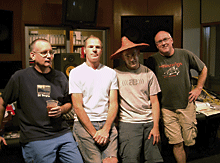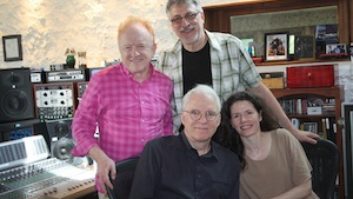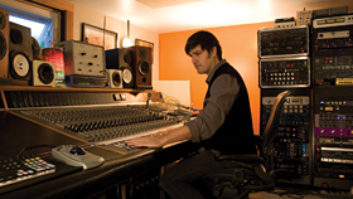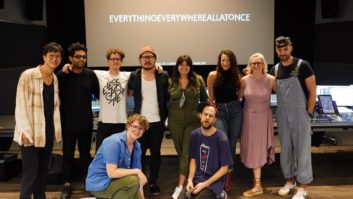
From left: Bob Stark, Dave Stricker, Dave Friedlander and Tim Ellis
On a cozy commercial strip in Portland, Ore.’s southeast quadrant lies a nondescript brick building that houses two storefronts. Walk around the corner, however, and you’ll find the entrance to one of the city’s most well-appointed new studios, Kung Fu Bakery (www.kungfubakery.com). In its three years of operation, the studio has hosted sessions with MTV rockers Everclear, the internationally beloved independents Pink Martini and indie pop stalwart Stephen Malkmus, as well as a slew of Pacific Northwest singer/songwriters.
The studio is a partnership of sorts: Its three main owners are Tim Ellis, Dave Friedlander and Dave Stricker. A fourth member, Bob Stark, maintains his own control room in the building, from which he is able to access tracking rooms when necessary. Before the Bakery, the four had all worked in various capacities at Portland’s now-defunct White Horse studios.
When the building that housed White Horse was sold, Ellis, Friedlander and Stricker intended to continue on together as a new business. Their original plan to build a modest production studio grew in nature when Ellis found a sizable commercial building on the market, one that had formerly been occupied by a kung fu studio and, of course, a bakery. Stark, who had planned to build his own mix room in another location, opted to build into this space. They put together an offer to purchase a good deal of White Horse’s equipment and some instruments.
The renovation took two-and-a-half years, with the members providing design input — addressing everything from layout to aesthetics. It helped that Stricker is a licensed contractor and headed the construction phase. The current layout feels spacious and stylish, but one of its chief assets is a floor plan that sets the two control rooms side-by-side, separated by a common machine room. To the side of these rooms are three tracking rooms of various sizes and liveness. All of the rooms have large windows — one can see virtually every tracking area from either control room. In addition, most of the rack gear is easily movable and available to either room, depending on where it’s needed at the time.
While the A room houses an SSL 6056E/G and Studer 820 and 807/Ampex ATR102 analog setup, both rooms record primarily to Pro Tools|HD2 Accel through 16 channels of Lavry converters (on two LE4496s). Stark’s room houses a Sony DMX-R100.
Stark and Friedlander are just as comfortable producing as engineering, and will happily take on either role. “I try to create an arc to the songs I produce, an interesting flow,” Stark says. “The responsibility to create that flow obviously falls on the writer and performer of the song, but it also falls on me as a producer. But I don’t want my thumbprint on it. I want it to feel like it’s something natural, something that the artist would have come up with.”
Stark refers to recent clients Intervision 5: “They’re a young band with good players; very easy to work with. I spent about a year going out and listening to these guys, offering suggestions on their songwriting. Still, once we got into the studio, we found we were still editing structure, cutting measures to get to lyrics quicker, adding bridge transitions or harmony lines to accent a lyric.”
Stark also mixed Tracy Grammer’s Flower of Avalon, which has found success in the folk world since its release earlier this year. Ellis, on the other hand, works primarily with singer/songwriters who are often sans band. Because of this, he says, “Part of my job is to add color and texture that work with the artist. I want a timeless sound, one that retains its dynamics. Another thing that we’re trying to retain is the sense that a song has been played from beginning to end, rather than a song where someone has come up with a lick and expanded it into a song.”
Ellis and Stark’s recent work with local artist Stephanie Schneiderman was an effort to strip down the basic tracks to provide space to maneuver in the mix. “Initially, the band was trying to rock out and Stephanie had to yell to get her voice heard over the clatter,” Ellis says. “I wanted her to be able to back off and focus on telling a story. If you’re able to strip the basics a bit, then during the mix, you have some room to move to add something cool.”
The Bakery staff finds that their approach can have effects that extend beyond the time clients spend there. “A lot of times, after recording with us, the artists find themselves taking the same approaches that we’ve worked on in the studio and incorporating them into their live performance.”
Rich Wells is a musician and freelance writer based in Portland, Ore.







